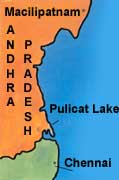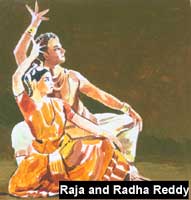
Dimdima
Online Children's Magazine from India

Dimdima
Online Children's Magazine from India

As we move north from Chennai, our journey takes us to one of South Asia's largest lagoons, the Pulicat Lake, a salt water lagoon formed out of the backwaters of the Bay of Bengal. It is located at the border of Tamil Nadu and Andhra Pradesh in the town of Pulicat. There are islands in the lake which abound in shells from which lime is manufactured.

Pulicat has a bird sanctuary that was established in 1976 to protect the resident birds as well as the flocks of flamingos and other migratory shore birds that visit here.
Pulicat town was one of the earliest settlements of the Dutch in India. A major portion of the lake lies in Andhra Pradesh, India's 5th largest state and the first state that was formed on a purely linguistic basis. Andhra Pradesh has a long coastline characterised by meandering mountains.  Cyclonic storms occur frequently, ravaging the vil-lages and towns along the coast and in the interior.
Cyclonic storms occur frequently, ravaging the vil-lages and towns along the coast and in the interior.
To the north of Pulicat Lake, in the Nellore district of Andhra Pradesh, lies the island of Sriharikota - the Indian Space Research Organisation's rocket-launching centre. India's first sounding rocket, Rohini, was launched from here on October 9, 1971.
 The island has seen the launching of 400 sounding rockets and 11 major satellites so far. A new launch pad is being constructed to accommodate larger launch vehicles.
The island has seen the launching of 400 sounding rockets and 11 major satellites so far. A new launch pad is being constructed to accommodate larger launch vehicles.
Converting the island into a spaceport has dislodged the Yanadis, a primitive tribe, who live in the thick forests of Sriharikota. Yanadis are mainly hunters. Many of them still produce fire by striking stones together.
Andhra Pradesh is an important producer of mica, most of which is mined in Nellore. Nellore, however,  is better known for its paddy fields and its association with Tikkana, a great poet who adorned the court of Manumasiddhi, a chief of Nellore and a vassal of the Kakatiya king, Ganapathi around the 12th century AD. Tikkana completed the translation of the Mahabharata begun by another of Andhra's great poets, Nannaya. Tikkana's translation earned him the title of Kavi Brahma. The small temple in which Tikkana composed this masterpiece serves as a cement godown today!
is better known for its paddy fields and its association with Tikkana, a great poet who adorned the court of Manumasiddhi, a chief of Nellore and a vassal of the Kakatiya king, Ganapathi around the 12th century AD. Tikkana completed the translation of the Mahabharata begun by another of Andhra's great poets, Nannaya. Tikkana's translation earned him the title of Kavi Brahma. The small temple in which Tikkana composed this masterpiece serves as a cement godown today!
The Andhra coast has two great deltas formed by the perennial rivers, Godavari and Krishna. The delta areas are known as the 'granaries of the south'.
 One of the tributaries flows through the village of Kuchipudi, where the famous dance form, Kuchipudi, is said to have originated. In the latter half of the 17th century, a great ascetic, named Siddhendra Yogi, conceived the Parijata Haranam - a poem that tells the story of how Sri Krishna's wife, Satyabhama, succeeded in persuading him to get the celestial Parijata tree planted in her garden. Siddhendra Yogi taught a group of boys in Kuchipudi to perform the Parijata Haranam.
One of the tributaries flows through the village of Kuchipudi, where the famous dance form, Kuchipudi, is said to have originated. In the latter half of the 17th century, a great ascetic, named Siddhendra Yogi, conceived the Parijata Haranam - a poem that tells the story of how Sri Krishna's wife, Satyabhama, succeeded in persuading him to get the celestial Parijata tree planted in her garden. Siddhendra Yogi taught a group of boys in Kuchipudi to perform the Parijata Haranam. 
The dance became extremely popular. When it was staged before Nawab Abdul Hasan Tana Shah, the last of the Golconda rulers and a great patron of fine arts, the nawab was so moved by the performance that he gave the village of Kuchipudi as a gift to Siddhendra Yogi and his dancing troupe, but on the condition that the village be used as a nursery to develop the newly created dance form. Siddhendra Yogi made his disciples promise that they as well as their sons would continue to stay at Kuchipudi and perpetuate this art and that every male member would play the role of Satyabhama at least once in his lifetime. Even today every boy in this village has a bell tied around his waist as a mark of initiation.
The dance form, however, has undergone a change over the years and is now no longer restricted to males.
At the mouth of the Krishna river lies Masulipatnam or Machilipatnam a well-known seaport in ancient times. It was a Dutch stronghold in the 1680s. The French captured Machilipatnam in 1750 and nine years later it fell into British hands.
Machilipatnam was one of the first British administered areas of Andhra Pradesh. It lost its strategic importance after it was devastated by a cyclone on 1 November,1864. It continues as a minor seaport and serves as the administrative area of the Krishna district.
Machilipatnam played an important role during India's struggle for freedom. Gadicharla Harisarvotthamarao, a staunch freedom fighter, founded the Andhra Jateeya Kalasala to train young men in modern technology in the cause of the Swadeshi Movement. Pingali Venkayya, also of the same place, is said to have designed our national flag.

Machilipatnam is the centre of Kalamkari painting on fabrics, an industry that is said to go back to 6th century B.C. The word Kalamkari means 'pen work'. Striking designs. depicting mythological themes were painted on the cloth with the help of penlike brushes. Nowadays wooden blocks are used instead of the traditional pens.
Last updated on :7/1/2005
Dimdima is the Sanskrit word for ‘drumbeat’. In olden days, victory in battle was heralded by the beat of drums or any important news to be conveyed to the people used to be accompanied with drumbeats.
Bharatiya Vidya Bhavan
K. M Munshi Marg,
Chowpatty, Mumbai - 400 007
email : editor@dimdima.com
Bharatiya Vidya Bhavan
505, Sane Guruji Marg,
Tardeo, Mumbai - 400 034
email : promo@dimdima.com
Dimdima.com, the Children's Website of Bharatiya Vidya Bhavan launched in 2000 and came out with a Printed version of Dimdima Magazine in 2004. At present the Printed Version have more than 35,000 subscribers from India and Abroad.